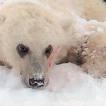Apparently it was assumed that the probability of a grizzly and a polar bear actually mating is nearly impossible, partly because polar bears mate on the sea ice and grizzly bears mate on the land. However, after a review of the bears DNA it was discovered that it was in fact a hybrid of polar bear and grizzly — perhaps the first ever seen and recorded in the wild.
The sport hunter from the United States said it had strange fur coloration. Both hunter and guide were surprised indeed, since the relationship between polar and grizzly bears is usually more adversarial. According to the Inuvialuit elders on the island, in the past there have been grizzly sightings but usually they fight with the polar bear.
The hide was turned over to the Environment and Natural Resources Department for testing. Additional analyses are underway to determine whether the mother was a grizzly bear or a polar bear and to determine the age of the bear.
It’s a fascinating discovery, it’s unfortunate that the bear was a victim of a hunters bullet. Regardless, the discovery of this new bear is firming up the belief that global warming or climate change is impacting both the grizzly and polar bear, and yet another example of the planet reacting to change very quickly.
We are witnesses everyday to wild habitat and the landscape in general, changing at such an extreme and rapid pace that most of us may not even notice until some of it has vanished entirely.
Often habitat and species disappear and often new species suddenly emerge. Consider climate change and how nature becomes stressed to adapt to these certain changes, then throw humans into the mix along with our socio-economic needs.
If the Grolar Bear is any indication, this hybrid bear may be nature’s attempt to stretch and adapt to a new environment in order to retain an ancient genome, then we came along and shot it. So it must strive again until it succeeds to adapt. We as human beings are as much part of the element of survival and destruction as climate change itself, or a predator, a cold winter, scarce food supply or perhaps a hurricane.
The economics of this event was a $50,000 guided trophy hunting excursion, but in fairness, it may have fallen prey to other elements in the natural world. It hardly matters, except the challenge now remains, we have discovered an event, and what do we choose to do?
Similar events surround us. In British Columbia’s southern interior, there are significant riparian areas that range from desert, interior rainforests, grasslands and alpine. All of these environments survive in the balance of just a few degrees of temperature, as do the living organisms that depend on those ecosystems to survive.
The small narrow valley I live in is so closely in the balance; one side of the valley boasts a cedar rainforest, while the other side is grassland and ponderosa pine. Two very different habitats and something that might not be noticed by passers by, but upon observing the changes annually in this riparian zone, significant changes are displayed annually within both habitats.
Urban development causes further stresses on ecosystems, much of the resulting impacts are difficult to reverse and there remains a short time to observe disappearing habitat, wildlife, and landscape.
No matter where you live, you might want to ask yourself the question, “Have I recorded and gathered the experiences that inspired me to enjoy the natural world that surrounds me?”
Few of us consider this question, this generation might see a number of environments disappear, as well as much of our traditional farmland. Our green spaces will take on a more urban function as “groomed” and risk free parks with fenced walkways, golf courses, and corporate forms of mono-crop agribusiness such as wineries.
And then of course there’s the wildlife, or lack of. As wildlife seeks to move into fringe areas due to population growth and development, so will we, and the two will clash; we’ve seen this with the bear population in this past decade.
Climate change is our elicitor to actually observe and prepare for shifting wildlife and plant habitat, but are we prepared? Perhaps its an opportunity to observe first hand how our world is changing?
There is a real opportunity for weekend travelers to begin to seek out these places where the planet is changing and to collect these experiences and the images within a journal and photo album or better yet a camcorder.
Be a responsible traveler and observe slowly and carefully; after all, you are now retaining a memory of something that is about to be lost forever, or discovered for the first time, like a Grolar Bear.
(30)

